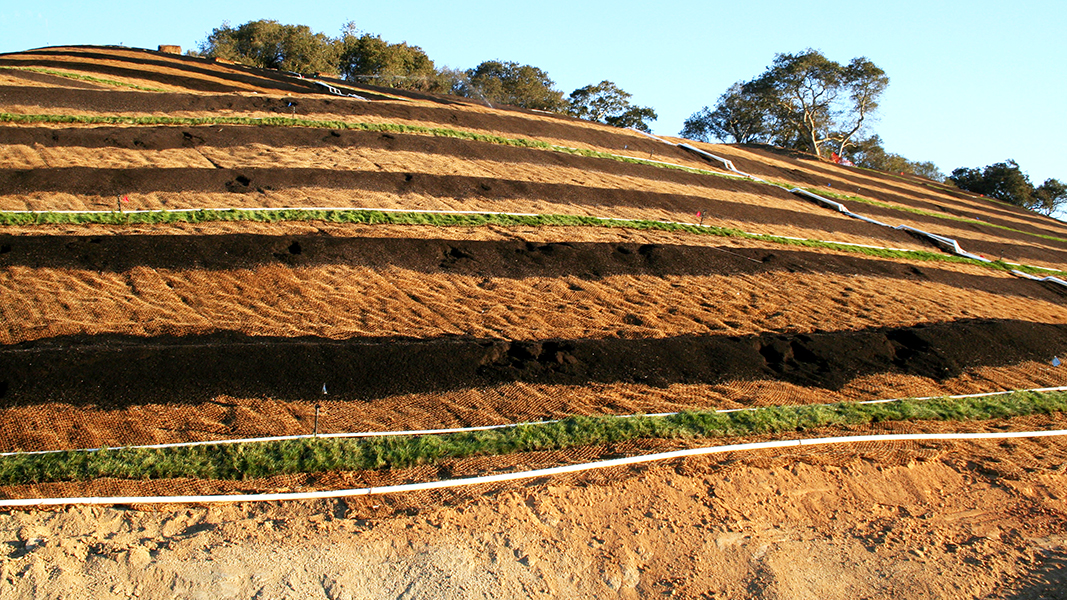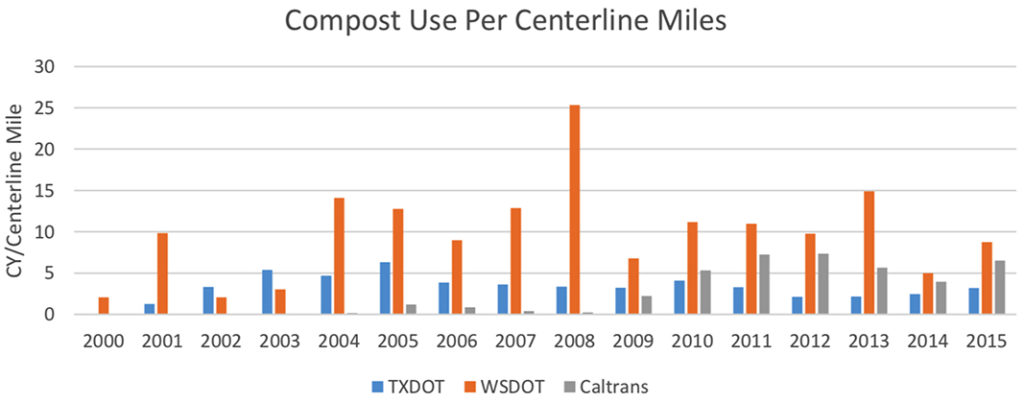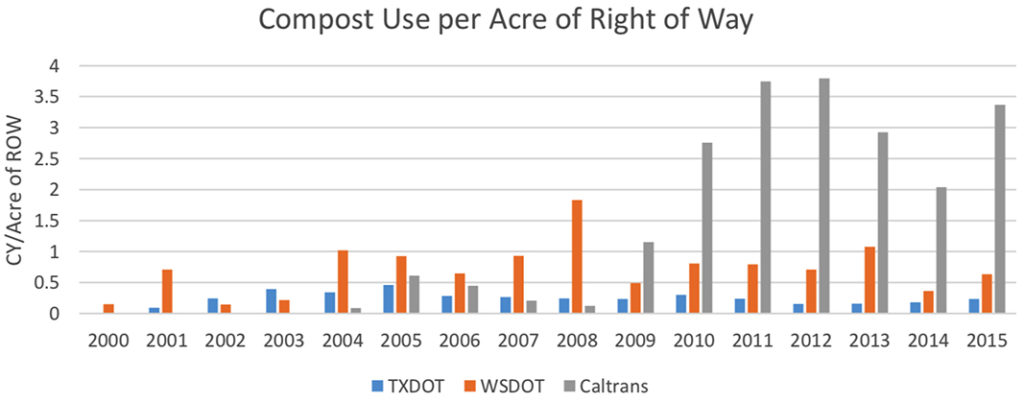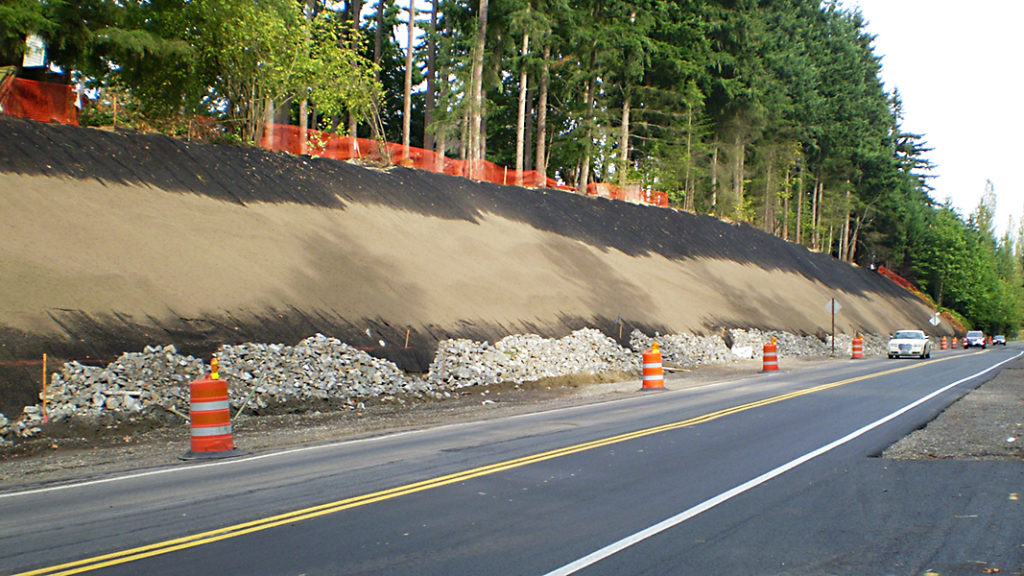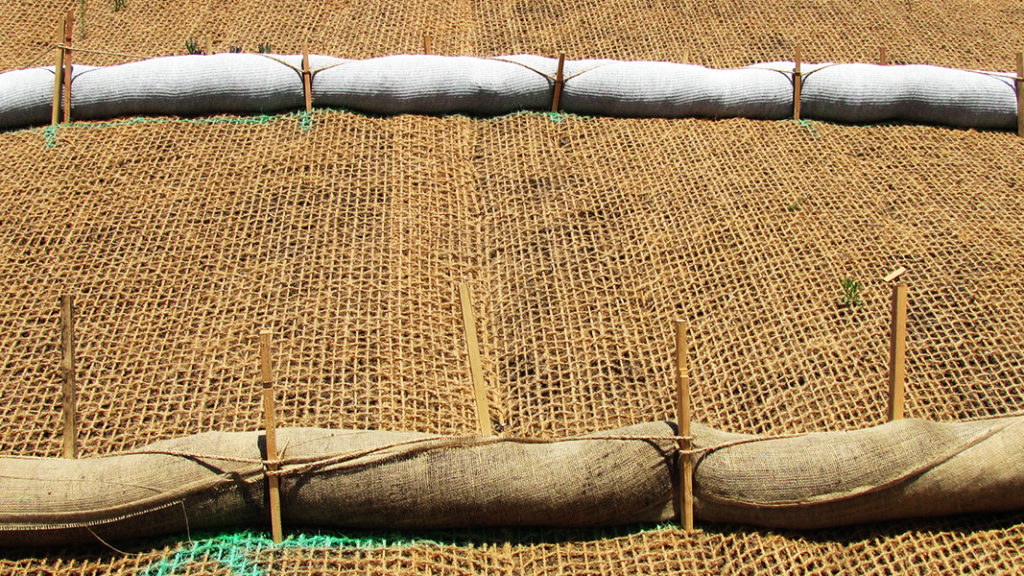
Sally Brown
A way to understand the potential for compost use on highways is to consider the centerline miles, which are a measure of how far a highway goes, not how wide it is. While Departments of Transportation (DOTs) also care about lane miles (number of lanes across) it is likely never going to be the case that DOTs put vegetative strips between lanes. Myself, I am content with the striped lines.
In certain states, compost use on highways is the way to go. For others it is a foreign concept. Texas (TX), Washington (WA) and California (CA) are three states that have found the value of the brown. That doesn’t mean that they each use the same amount of compost or that they use it for the same reasons. If you are a compost producer, doing business with a state DOT typically means doing big business. For TX and WA, the DOT is the single biggest user of compost in the state. Washington wins the race here with more use per centerline mile than the other two states (Figure 1).
It is also important to consider how much of the highway has soil on the side (the right of way). If your road is surrounded by concrete, there is minimal potential for compost use. Here the CA Department of Transportation (Caltrans) is the baby with only 29,000 acres. Want wide open spaces, you should drive north to WA (97,500 acres) or head east to TX (1.1 million acres). Despite having a relatively few acres to work with, however, CA is the clear winner in terms of compost use per acre on right of ways (Figure 2).
Utilization Patterns
Even with these high rates of use, compost application to highways in these states is well below its potential. An early estimate, developed by the US Composting Council (USCC) and Composting Council Research and Education Foundation (CCREF) estimated that use could be as high as 3.35 to 6.725 million cubic yards if compost was applied annually to a depth of 1- to 2-inches on all land for which Caltrans had developed landscaping plans.
Ryan Batjiaka, a former graduate student of mine, looked into compost use in each of these states. He interviewed folks at each agency about how compost use started in their programs, how it is currently used and what the obstacles are to increasing its use. Most of the time, compost is used for new construction and to control erosion. The following summarizes use of compost in WA and CA:
- Washington State: Regulations require that right of ways are maintained with stable plant communities that resist weeds, meet a range of environmental and operational standards, have minimal environmental impact and are cost-effective. There are also requirements to use recycled products; in fact, it is regulated that at least 80% of what is spent on soil amendments must be spent on compost. One of the uses is for storm water control. Compost put in socks, berms and blankets not only keeps the toe of the slope in place, it stops rainwater from ponding on the highway. It is also used for vegetated filter strips and bioswales. A major use is for erosion control. This explains why use in WA per centerline miles is so high.
- California: The situation in CA is somewhat different. Regulations don’t require compost use and while Caltrans uses a lot of compost, the practice isn’t consistent across the different regions. Compost use for highways started in the state when the then Integrated Waste Management Board (now CalRecycle) reached out to Caltrans to encourage compost use. Utilization really began to increase in 2009. Previously, it was less than 5,000 cubic yards/year — enough for about one vegetated swale. Much effort was put into outreach and education. Unfortunately, mistakes were made. In one exceptionally bad case, a high lead compost was used for a project. Regulators rightly forced removal of all the contaminated material that had been applied at great expense.
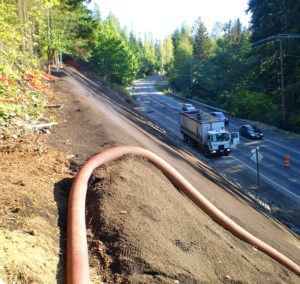
Opening photo (top of page): Slope with completed treatments and temporary irrigation system. (Above) Application of compost blanket Photos courtesy of Caltrans
Since that time, clear specifications for compost have been developed (thank you Ron Alexander, R. Alexander Associates) and the USCC’s Seal of Testing Assurance (STA) program has been put into place. Despite this progress, there are regulatory concerns that composts will leach nutrients and be a source of contamination rather than a sink.
Finally, there is competition from other products. Many highway landscape architects and engineers are not accustomed to working with compost, even in a relatively high use state like CA. Many are used to dealing with proprietary products, such as bonded fiber mulch (BFM). This is a product that can be applied with a hydro-seeder. It consists of woody fibers applied with a tackifier (read paper mache). If you try the compost and use it correctly, as in the Central coast (Caltrans District 5), you’ll see no purchase orders for BFM. If you drive further south to the San Diego area you’ll find high use of BFM and no consideration of compost.
If composters start upping their game, the situation can change rapidly. Once landscape architects starting using specialized compost products like blankets and socks, use increased rapidly. From 2010 to 2015 over 15,000 yards of socks have been used. California — despite very high use relative to WA and TX when considered on an acre right of way basis — still has a long way to go.
Just How Much Potential?
In Part I of this series, I talked about how using compost along highway right of ways will do the same for that soil as it does for your gardens or your fields. Here, I’ve talked about specialized uses for compost on highways. The big three are: Vegetation establishment on new construction; Erosion control; and Storm water mitigation.
Even with use limited to these special categories, the three state DOTs that have embraced compost use comprise a majority of compost sales within those states. What if these same DOTs used compost the way a homeowner or a farmer does? A one-time special case application for these users doesn’t cut it. Annual applications, improving the soils more each year, are a much more typical way to go. I’ll do my own quick version of the USCC estimate of potential compost demand here based on the total California right of way acreage.
- Tons/year of compost: 29,000 right of way acreage x 5 tons of compost = 145,000 tons/year of compost.
- Carbon sequestration: Using the estimate for CO2 sequestration per ton of compost used on highways that I did for WA State (1.2 tons of CO2/ton of compost): 145,000 tons of compost x 1.2 tons of CO2/ton of compost = 174,000 tons of CO2. That is pretty impressive for just one state, one with puny right of way acreage at that.
- Impact on compost supply: I did a ballpark estimate that the 39 million people in CA could make about 750,750 tons of yard/ food scrap compost a year. If highways used the compost the same way a good farmer does: 145,000 tons of compost for Caltrans/750,750 total tons of compost = 19% of the total compost produced.
Now in the nitrogen column, part of the Drawdown series, I used an estimate of 27.6 million acres of irrigated farmland that could use compost. That didn’t count the forestry acreage in California (33 million). It also doesn’t take into account the quantity of compost that people like me want for their tomatoes and their lawns. In short, using compost for highway right of ways is a great end use, one that would help state budgets and reduce headaches for roadway landscape architects. In all likelihood, it would even been good for those stuck in traffic, having something nice to look at on the side of the road. Getting these people who work within a jungle of regulations and are surrounded by engineers who love pavement above all else isn’t easy, but it can be done. Just don’t you dare short me out of my share.
Sally Brown, BioCycle’s Senior Adviser and long-time Connections columnist, is a Research Professor at the College of the Environment at the University of Washington.


